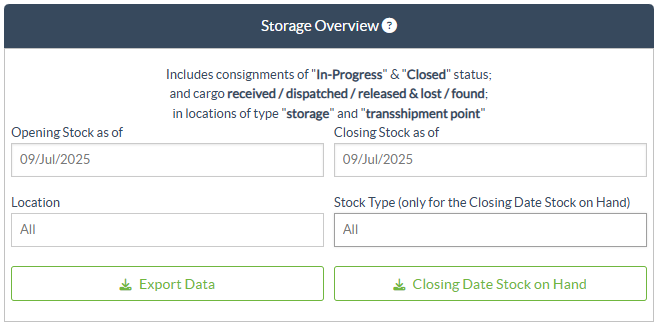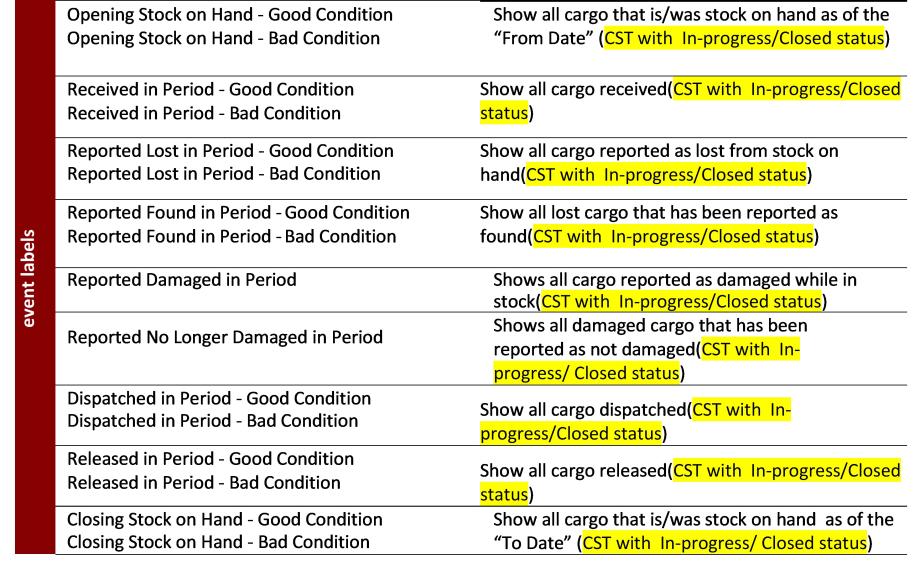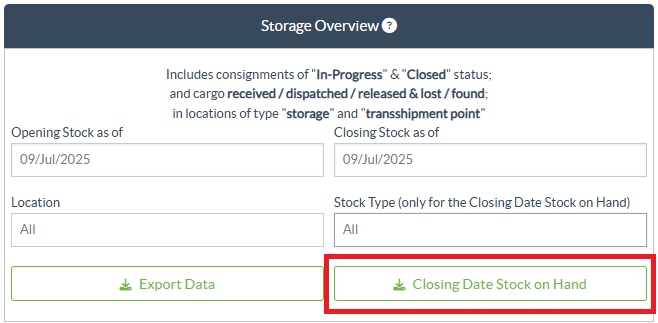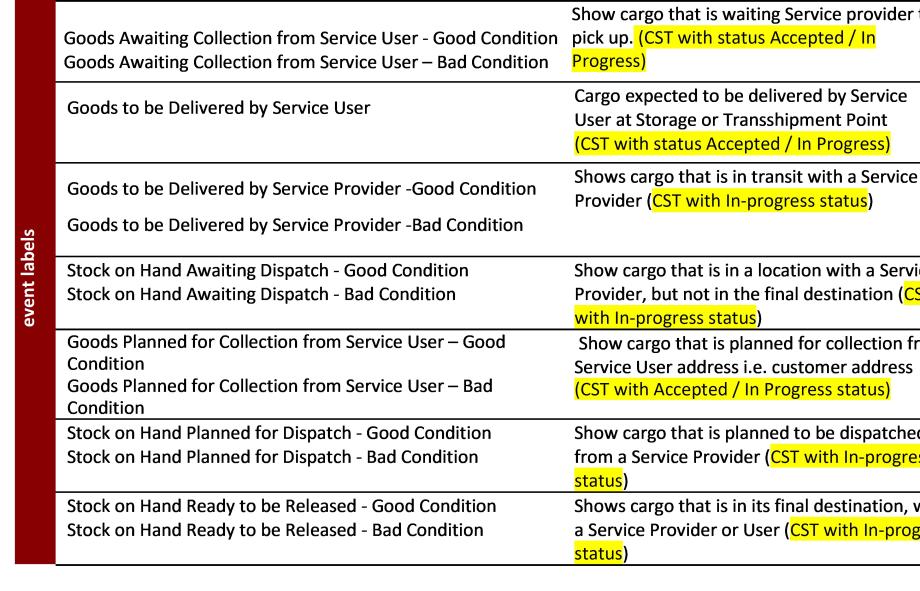Storage Overview
This option will extract transaction-level data for all storage service(s) that have been registered by the respective Service Provider(s), over the full duration of the Project or within the date-range specified on screen; the “From Date” and “To Date” (see below) can be set to any value and will define the date-range for the Export[ed] Data. Additionally, for the purposes of managing single warehouses, the Export[ed] Data can be filtered by “Location” before download.
The “From Date” and “To Date” values will be checked against the “Actual” Receive/Dispatch/Release Date, or date when a loss or find was reported for all recorded storage service(s); any opening stock and receive, dispatch, release, loss or find that occurred at a ‘storage’ or ‘transhipment’ type location, between or on these dates will be included in the Export Data that is downloaded. The “Location” value, if provided, will be checked against all ‘storage’ and ‘transhipment’ type locations where cargo is on- hand or was received, dispatched, released, lost or found; any qualifying transaction that occurred at the matching location will be included in the Export Data that is downloaded. The "Stock Type" value allows for reports separate cargo either as "All" cargo, or cargo that is either "anticipated" or "planned". |
After entering a date-range (by default, the date range is set to the current day only) or filtering by Location (only if needed, this field can be left blank), the data can be exported and downloaded by clicking on the “Export Data” button/bar.
You can, for example check all cargo received in a single month or quarter, and sum the total volume by day, by product category and by Service User.
The Storage Overview data may include the following Events, and corresponding values for date and cargo quantity (IU, HU, weight, volume, value) as well as additional details such as temperature control (if applicable, including minimum and maximum temperatures) and dangerous goods identification (if applicable, showing the DG ID). Further, cargo quantities may be positive or negative depending on the event (i.e. “Opening Stock” and “Received in Period” quantities are positive while “Dispatched in Period” and “Released in Period” quantities are negative, so any positive balance indicates cargo currently in stock).
The Storage Overview data may include other details and references for the events, based on relevance of data captured in RITA to the management of storage services.
Simplified Stock Reporting
RITA users can quickly generate a simplified “stock on hand” report for their storage by selecting the option “Closing Stock on hand”.
This report enables users to extract simplified "Stock on Hand" data for all storage service(s) registered by the respective Service Provider(s). The report will be limited to a specific date, defined by the "To Date" field on the screen. Users may also filter the data by "Location" to generate warehouse-specific exports.
By selecting "Closing Stock on Hand", RITA users can quickly generate a report that shows the closing stock available at their storage facility on a specified date (by default, the date range is set to the current day only).
The Closing Stock on Hand may include the following Events, and corresponding values for date and cargo quantity (IU, HU, weight, volume, value)
EVENT LABEL | Closing Stock on Hand - Good Condition Closing Stock on Hand - Bad Condition | Show all cargo available at the storage facility (total quantity of stock less the committed and planned stock) as of the “To Date” |
Closing Stock on Hand-Committed - Good Condition Closing Stock on Hand-Committed - Bad Condition | Show all cargo quantity reserved under requested Release Order. | |
Closing Stock on Hand-Planned - Good Condition Closing Stock on Hand-Planned - Bad Condition | Show all cargo quantity assigned to a Planned Journey that has not yet been dispatched. |
RITA operators can also select individual reports based on both "Committed Stock" and "Planned Stock", which will display only the cargo items in those specific states. A report with "All" will deliver a report with all cargo in all conditions.
Storage Planning
This option will extract transaction-level data for all storage service(s) that have been registered by the respective Service Provider.
This option will extract relevant data for all service requests, or Consignments that are awaiting some action at a Service Location by the Service Provider (i.e. Receipt from a Service User, Dispatch to another location, or Release). Additionally, for the purposes of managing single warehouses, the Export[ed] Data can be filtered by “Location” before download.
| The “Location” value, if provided, will be checked against all ‘storage’ and ‘transhipment’ type locations where cargo is expected to arrive, be collected, or is currently on-hand with a Service Provider; any service that will take place or is currently underway at the matching location will be included in the Export Data that is downloaded. All storage’ and ‘transhipment’ type locations can be collectively referred to as “Service Locations”, these are specific facilities where a Service Provider is responsible for cargo on- hand. |
After entering any required information to set a specific location of interest (this field can be left blank) the data can be exported and downloaded by clicking on the “Export Data” button/bar.
You can, for example check for cargo expected to arrive at a warehouse and sum the total weight by sending organization and expected date of arrival.
The Storage Planning data may include the following Events, and corresponding values for date and cargo quantity (IU, HU, weight, volume, value). Further, in this case all cargo quantities will be positive (i.e. all events reflect some positive quantity of cargo awaiting some action to be taken).
The Storage Planning data includes details of three locations. Understanding the relationship between these locations, the overall/full service originally requested, and the “Events” is necessary to effectively use the information consolidated in RITA to plan storage services.








